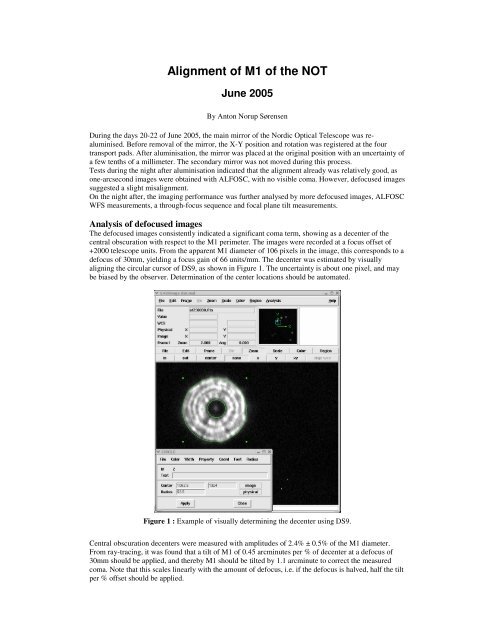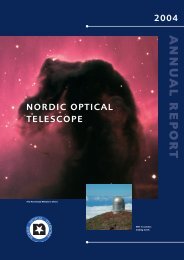alignment procedure - Nordic Optical Telescope
alignment procedure - Nordic Optical Telescope
alignment procedure - Nordic Optical Telescope
You also want an ePaper? Increase the reach of your titles
YUMPU automatically turns print PDFs into web optimized ePapers that Google loves.
Alignment of M1 of the NOT<br />
June 2005<br />
By Anton Norup Sørensen<br />
During the days 20-22 of June 2005, the main mirror of the <strong>Nordic</strong> <strong>Optical</strong> <strong>Telescope</strong> was realuminised.<br />
Before removal of the mirror, the X-Y position and rotation was registered at the four<br />
transport pads. After aluminisation, the mirror was placed at the original position with an uncertainty of<br />
a few tenths of a millimeter. The secondary mirror was not moved during this process.<br />
Tests during the night after aluminisation indicated that the <strong>alignment</strong> already was relatively good, as<br />
one-arcsecond images were obtained with ALFOSC, with no visible coma. However, defocused images<br />
suggested a slight mis<strong>alignment</strong>.<br />
On the night after, the imaging performance was further analysed by more defocused images, ALFOSC<br />
WFS measurements, a through-focus sequence and focal plane tilt measurements.<br />
Analysis of defocused images<br />
The defocused images consistently indicated a significant coma term, showing as a decenter of the<br />
central obscuration with respect to the M1 perimeter. The images were recorded at a focus offset of<br />
+2000 telescope units. From the apparent M1 diameter of 106 pixels in the image, this corresponds to a<br />
defocus of 30mm, yielding a focus gain of 66 units/mm. The decenter was estimated by visually<br />
aligning the circular cursor of DS9, as shown in Figure 1. The uncertainty is about one pixel, and may<br />
be biased by the observer. Determination of the center locations should be automated.<br />
Figure 1 : Example of visually determining the decenter using DS9.<br />
Central obscuration decenters were measured with amplitudes of 2.4% ± 0.5% of the M1 diameter.<br />
From ray-tracing, it was found that a tilt of M1 of 0.45 arcminutes per % of decenter at a defocus of<br />
30mm should be applied, and thereby M1 should be tilted by 1.1 arcminute to correct the measured<br />
coma. Note that this scales linearly with the amount of defocus, i.e. if the defocus is halved, half the tilt<br />
per % offset should be applied.
A rotator angle of -90 degrees was used, making the axis of ALFOSC vertical. The decenter was<br />
estimeted to be purely horizontal in the images, and an east-west tilt correction of M1 was applied by<br />
adjusting the height of load-cells 1 and 2. Load-cell 1 was adjusted by a quarter turn clockwise, seen<br />
from below, and #2 a quarter turn counter-clockwise. Assuming that the screw pitch is 1mm/turn, this<br />
corresponds to a tilt of tan -1 ((0.25+0.25mm)/210cm) = 0.82 arcmin. The effect on the defocused image<br />
is shown in Figure 2, middle. Contrary to expectations, the applied tilt is clearly too strong. The<br />
correction was then reduced so that the adjustment relative to the original position was: 1/16 turn<br />
clockwise for load-cell 1 and 1/16 turn counter-clockwise for load-cell 2. M1 has then been tilted 0.2<br />
arcminute. A defocused image after this is shown in Figure 2, right. The central obscuration now<br />
appears properly centered.<br />
Figure 2 : Defocused images used for estimating the coma term. Left: Before correction. Middle: Too<br />
strong correction. Right: After final correction.<br />
In-focus analysis<br />
A through-focus sequence was aquired before the change of M1 tilt, consisting of 9 exposures of 5<br />
second duration, with telescope focus from +100 to -100 in steps of 25 relative to the best focus, as<br />
determined with the focus pyramid. Measurements of FWHM and elongation are given in Figure 3.<br />
The FWHM dependence on focus is surprisingly weak, as a defocus of 100 steps results in a 1.0 arcsec<br />
disc.<br />
Close to focus, an increase in elongation is evident. This decreases away from focus, as the defocus<br />
disc dominates. A measurement from the night before (diamond symbol) indicates low elongation in<br />
focus, but this may be masked by the somewhat poorer seeing. After coma correction (asterix symbol),<br />
a low FWHM with low elongation is achieved.<br />
Figure 3 : Left: Image FWHM versus telescope focus. Right: Image elongation versus telescop focus.<br />
Symbols: Line with plusses is from through-focus sequence. Asterix is after M1 coma correction.<br />
Diamond is from the night before correction.
WFS measurements<br />
WFS data were acquired for two stars at zenith distances of 6° and 19°, respectively, with five<br />
exposures of each. The data were reduced briefly after the acquisition. Seeing was adequate, at 0.8 – 1<br />
arcsec, and all but one exposure provided consistent results. Nevertheless, it was decided not to use the<br />
WFS output as basis for the M1 correction. After the correction, three WFS exposures were acquired of<br />
a star at ZD=11°. The amplitudes for a number of low order aberrations are plotted in figure Figure 4.<br />
Considering that the two graphs for measurements made before coma correction are the average of<br />
respectively 5 and 4 WFS measurements, there is a considerable scatter. For the WFS measurement<br />
made after tilting M1, Z 7 , the horisontal coma term, has clearly changed amplitude, as expected. From<br />
this measurement alone, it would appear that the applied coma correction was too strong.<br />
Figure 4 : Zernike amplitudes measured with the ALFOSC KH-WFS. Measurements before coma<br />
correction are shown with dashes lines, and after with solid lines. First term is Z 3 , defocus. Coma are<br />
Z 6,7 .<br />
Off-axis aberrations<br />
While on-axis coma appears to have been reduced to an acceptable level, there may still be significant<br />
abberations in the field. An article by McLeod describes how to measure and correct for off-axis<br />
astigmatism. The measurement was attempted by using the guide camera, but had to be aborted due to<br />
clouds and because a <strong>procedure</strong> for quickly moving the telescope and guide camera as required had not<br />
been worked out. Briefly described, elongation due to astigmatism of an image defocused by 3mm is<br />
examined at a number of field positions in a circle some 6-8 arcminutes from the optical axis. The staff<br />
is encouraged to try the method.<br />
Focal plane tilt<br />
A number of measurements were made of the telescope focal plane tilt using a focus pyramid with<br />
ALFOSC, and internal FOSC FP tilt using Hartmann masks. The preliminary results indicate that the<br />
measurements are not useful for charaterising the telescope performance. The analysis will be<br />
discussed elsewhere.<br />
Conclusion<br />
The process of measureing the location of M1 before aluminisation and re-install it to this position with<br />
high precision has proven successful, as very little on-axis coma was detected afterwards. The<br />
telescope has been aligned to provide good on-axis performance. The imaging quality at large field<br />
angles has not been properly examined.<br />
References:<br />
McLeod, Brian A, “Collimation of Fast Wide-Field <strong>Telescope</strong>s”, PASP, 108: 217-219, 1996 February



